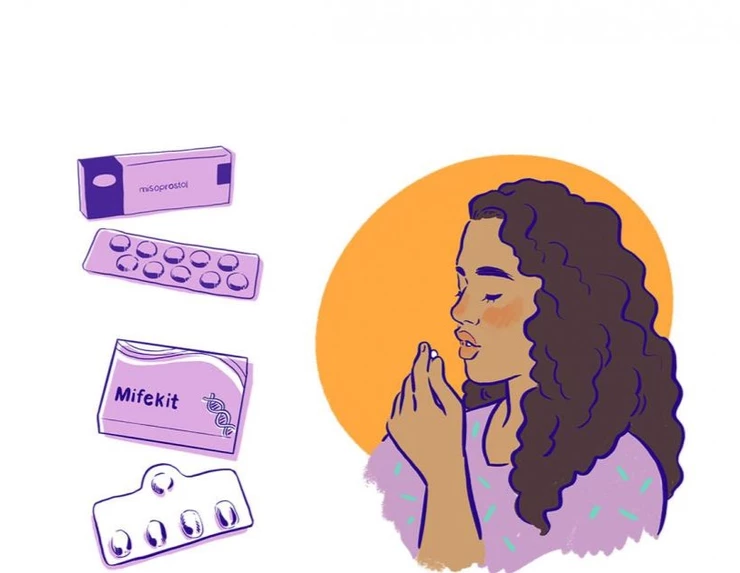Could Self Managed Abortions be the Future of Reproductive freedom: What does research say?
One of the major lessons of the covid 19 pandemic has been the revelation of how broken the public health delivery systems are in our region and indeed in many other parts of the world.
As countries and people grapple with a crippling lack of healthcare personnel and difficulties in access to clinics, hospitals and medicines, many are beginning to see the potential of self- care and decentralized de-medicalized, non- traditional systems of care. This includes telemedicine of course but also the more politically radical self- managed care in the context of safe abortion services.
Here are some studies and articles that offer insight into the advantages from a clinical and scientific perspective.

Image source – International Planned Parenthood Federation
Joanna N Erdman , Kinga Jelinska, Susan Yanow
This commentary explores how self-managed abortion (SMA) has transformed understandings of and discourses on safe abortion and associated health inequities through an intersection of harm reduction, human rights and collective activism.
The article examines three primary understandings of the relationship between SMA and safe abortion: first SMA as health inequity, second SMA as harm reduction, and third SMA as social change, including health system innovation and reform. A more dynamic understanding of the relationship between SMA, safe abortion and health inequities can both improve the design of interventions in the field, and more radically reset reform goals for health systems and other state institutions towards the full realization of sexual and reproductive health and human rights.
Effect of a smartphone intervention on self-managed medication abortion experiences among safe-abortion hotline clients in Indonesia: A randomized controlled trialCaitlin Gerdts , Ruvani T Jayaweera, Ika A Kristianingrum , Zara Khan , Inna Hudaya
This study represents the first-ever randomized control trial (and prospective study) among those who contacted a safe-abortion hotline for information about and support for self-managed abortion. Levels of preparedness, confidence, and feelings of support were all extremely high among both control and intervention arms-indicative of the high-quality, evidence-based information, comprehensive, and supportive abortion counseling that safe-abortion hotline clients receive.
Self-administered versus provider-administered medical abortionKatherine Gambir , Caron Kim, Kelly Ann Necastro, Bela Ganatra , Thoai D Ngo
This review shows that self-administering the second stage of early medical abortion procedures is as effective as provider-administered procedures for the outcome of abortion success. There may be no difference for the outcome of ongoing pregnancy, although the evidence for this is uncertain for this outcome.
There is very low-certainty evidence for the risk of complications requiring surgical intervention. Data are limited by the scarcity of high-quality research study designs and the presence of risks of bias. This review provides insufficient evidence to determine the safety of self-administration when compared with administering medication in the presence of healthcare provider supervision. Future research should investigate the effectiveness and safety of self-administered medical abortion in the absence of healthcare provider supervision through the entirety of the medical abortion protocol (e.g. during administration of mifepristone or as part of a misoprostol-only regimen) and at later gestational ages (i.e. more than nine weeks). In the absence of any supervision from medical personnel, research is needed to understand how best to inform and support women who choose to self-administer, including when to seek clinical care.
Self-managed abortionJennifer Conti 1, Erica P Cahill
With the exponential rise of restrictive antiabortion laws in the United States, it has become increasingly difficult to access safe and legal abortion services. One response to this hostile environment for reproductive care access is an increased interest in methods of self-induced or self-managed abortions, primarily by medications sourced outside the medical setting.
Compared with clinic-based care, the two most pressing concerns regarding the safety of self-managed abortion are that people seeking abortion will incorrectly self-identifying as appropriate candidates and that they will not know or be able to access medical care if needed. There is therefore an increasing need for medical providers to learn about and researchers to evaluate the incidence, safety and efficacy of self-management of abortion. Simultaneously, reproductive law experts must continue to develop and educate on the legal frameworks to protect and decriminalize people seeking self-managed abortion as well as their care providers.
Emerging research suggests that abortion outside the medical setting, or self-managed abortion, is an overall safe and effective way to end a pregnancy. However, significant legal barriers and stigma remain. The safest environment for self-managed abortion (SMA) is one where accurate information is available, medical care is accessible when needed, and all methods of abortion remain legal.
M Endler , A Lavelanet , A Cleeve1, B Ganatra , R Gomperts , K Gemzell-Danielsson
Based on a synthesis of mainly self-reported data, medical abortion through telemedicine seems to be highly acceptable to women and providers, success rate and safety outcomes are similar to those reported in literature for in-person abortion care, and surgical evacuation rates are higher.
Self-management of first trimester medical termination of pregnancy: a qualitative study of women’s experiencesC Purcell , S Cameron, J Lawton , A Glasier , J Harden
Women in Scotland who had undergone medical TOP ?63 days, and self-managed passing the pregnancy at home primarily found self-administration of misoprostol and home self-management to be acceptable and/or preferable, particularly where this was experienced as a decision made jointly with health professionals. The way in which home self-management is presented to women at clinic requires ongoing attention. Women could benefit from the option of home administration of misoprostol.






